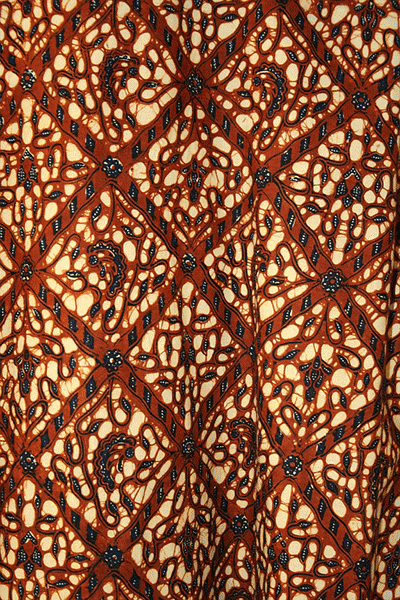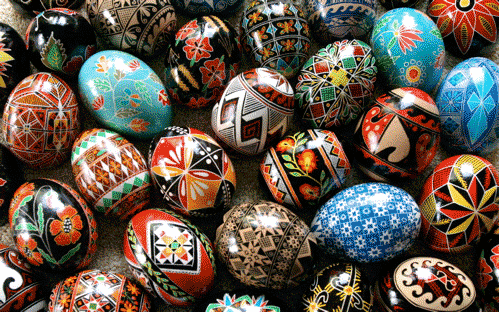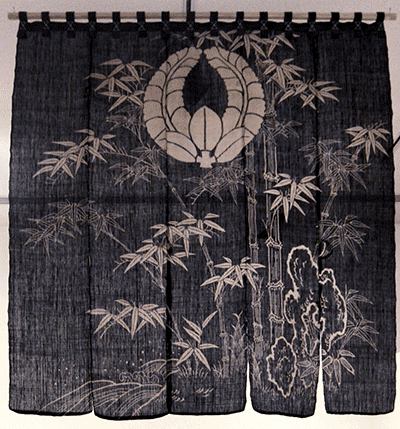Resists
The technique of combining media that repel or rebuff each other would be called resist. There are a variety of media that can be used this way.
Wax is a common resist material. Applied in a hot, liquid state, it dries and protects areas of the material or support from the dye or paint being used. Wax resist techniques go back as much as 2000 years with origins possibly in the Middle East or Asia.
Interesting facts about using wax: Isabella Whitworth Wax Resist Techniques
Batik involves painting designs on fabric - cotton or silk mainly - with hot wax, then dyeing the cloth. Designs are built up in layers utilizing multiple dyes. The art of batik was exemplified in southeast Asia, namely Indonesia and Malaysia.

Indonesian batik fabric
Sites about the batik process:
Batik Guild: What is Batik?
Batik, the Traditional Fabric of Indonesia
Fine Batik History and Background
Batik Winotosastro
The Process of Making Batik - YouTube
A similar wax resist process was used on pottery as much as 1200 years ago. Wax is painted on pottery before glaze is applied, keeping the waxed areas free of glaze when fired.
Sites about the pottery wax resist technique:
Ceramics Wax Resist Tips
Ceramics Arts Daily: Resistance is Not Futile
NGA Inca Pottery Resist
Ukranians have also used the wax resist process for generations in the art of Pysanky, or Easter egg decoration. Elaborate traditional designs are drawn on the eggs with a tool called a tjanting (the same tool used in batik) and dyed. The designs are built up in many layers, waxing between dye baths.

A mix of modern and traditional Ukrainian pysanky
Sites about Pysanky:
Pysanky
Learn Pysanky
Pysanky - Ukrainian Easter Eggs
Watercolor artists use wax as a resist to preserve the white of the paper or to build up layers of color. Often, hard wax is drawn right on the paper before paint is applied to create a texture.
Paste has been used as a resist for centuries. The process is similar to wax resist but instead of wax, a paste mixture is applied on the fabric or support and dye or paint is added after, sometimes in layers.
Adire is an indigo dyed cloth produced in Yoruba, Nigeria since the early 20th century. It replaced an older process of dying tied fabric and consists of a variety of processes including paste resist, stitching and binding with raffia. Adire Eleko is the specific technique using cassava starch paste to draw designs on fabric before dying in an indigo dye.
Examples of Adire Eleko:
The Metropolitan Museum Adire Eleko
Adire Indigo Resist Dyed Cloth
Adire African Textiles
Tsutsugaki is a Japanese resist technique. A rice flour and water paste is applied to fabric with a cone shaped applicator called a tsutsu. It is then dyed in indigo dye, then the paste is scraped off. This process originated in the 17th century.

Noren (curtain), Japan, Meiji period (1868-1912), hemp, cotton (loops), indigo dye and sumi ink, plain weave, tsutsugaki (tube drawn) rice paste resist, dip-dyed in indigo, brushed ink, Honolulu Museum of Art
Examples of Tsutsugaki:
Tsutsugaki Textiles
Above images from Wikipedia.
Some sites about paste resist:
A Flour Paste Batik Process
There are a variety of other materials that can be used as a resist. Oil pastels are often used with waterbased paint as a resist technique. The bright colors of the pastels can be intensified with dark paint or unified with vibrant colors.
Gel Medium applied to gesso creates a subtle resist when water based paint is applied on top. Here is a simple explanation of the technique:
Create Mixed Media: Gel Medium Resist
Another common resist technique is to apply waterproof ink over tempera paint. When the ink dries, the image is rinsed with water and the ink is removed from on top of the paint. This technique can create some unique painterly effects.
Sites about Tempera Resist:
Gouache Resist Tutorial
Ink Resist Technique
Sandra L Jones: Tempera Resist
Watercolor and Ink Resist Technique
Sherry Berger
Resist for Students:
Art of Ed: Chalk Resist Paintings
Over the Moon: School Glue Resist
A variety of resist techniques:
International Folk Art Resist Dye Techniques
Judy Coates Perez Simple Resist Technique
Petroleum Resist Technique
Isabella Whitworth Silk Painting


